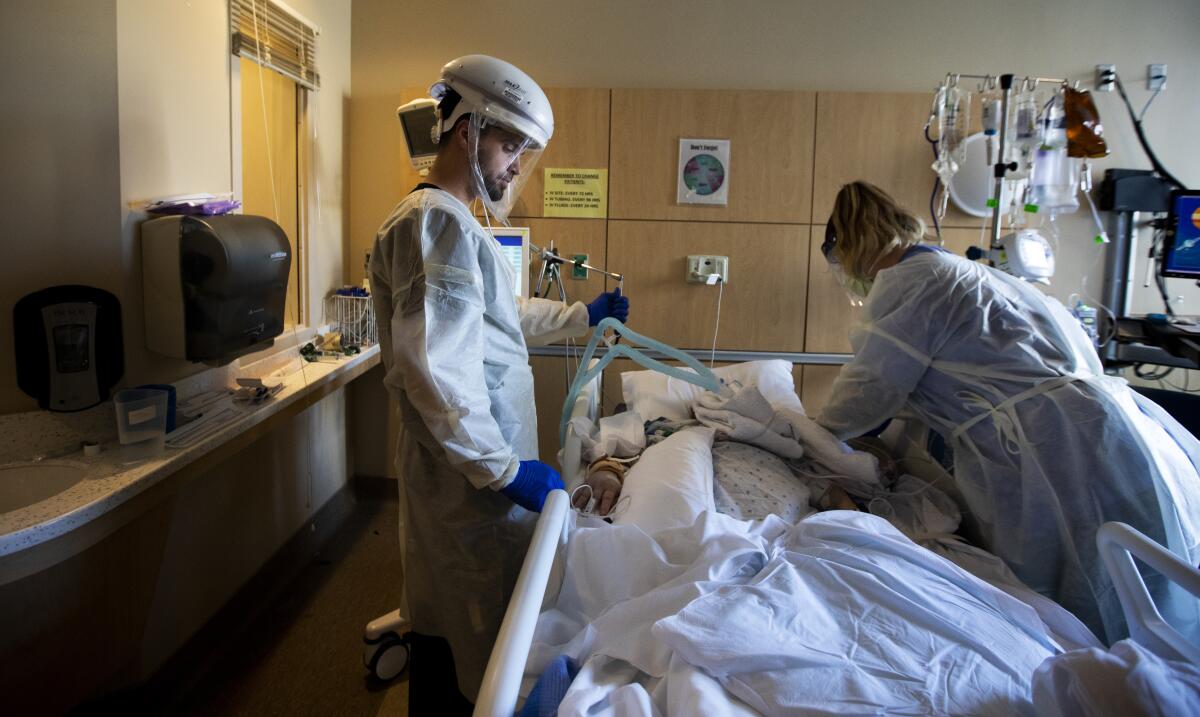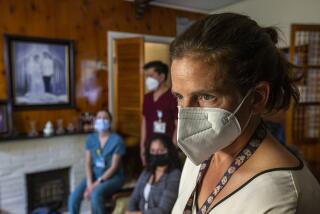After hitting L.A., COVID-19 wave now battering Southern California’s suburban counties

- Share via
When the autumn COVID-19 surge erupted more than a month ago, the epicenter was once again Los Angeles County, where the large population of essential workers and others living in densely populated neighborhoods made the region particularly vulnerable to the rapid spread of infections.
But now, Southern California’s more suburban counties are rapidly catching up, fueled by Thanksgiving gatherings that have pushed coronavirus cases and hospitalizations to unprecedented levels and left hospital intensive care units at critical levels.
The numbers of people hospitalized for COVID-19 in Los Angeles, San Diego, Orange, Riverside, San Bernardino and Ventura counties have all doubled since the week of Thanksgiving, according to a Times analysis.
The suburban counties are also tallying record levels of new daily infections — all substantially worse than the summer surge, and in many cases, at a rate of increase worse than L.A. County. While L.A. County has seen its latest average daily number of cases nearly triple from its summer peak, counties in even worse shape relative to their summer highs include Ventura, San Bernardino and San Diego counties.
Riverside County is in the worst shape relative to its summer maximum, more than quadrupling its average daily number of cases from its peak in August. On Thursday, Riverside recorded an average of nearly 3,500 cases a day over the past week, far worse than the comparable peak of nearly 800 in August.
On a per-capita basis, L.A. County has tallied more coronavirus cases per 100,000 residents over the last week than Ventura, San Diego and Orange counties but fewer than Riverside and San Bernardino counties.

Intensive care unit capacity continued to deteriorate across Southern California, with availability in Southern California falling to 6.2% from 7.7% a day earlier.
“The velocity of the increase — or the steepness of the curve — is much more prominent now than it was earlier,” said Dr. Robert Kim-Farley, medical epidemiologist and infectious diseases expert at the UCLA Fielding School of Public Health.
“I think that it is a result of the widespread transmission that was occurring over the Thanksgiving holidays such that so many people — either asymptomatic or presymptomatic people — were spreading the disease not only among themselves but within their own families,” Kim-Farley said.
That’s why it is so important for Californians to follow the stay-at-home order as much as possible in the coming weeks, Kim-Farley said, to contain the spread of the highly contagious virus and prevent even worse calamity as winter begins. Unless current trends change, the University of Washington’s Institute for Health Metrics and Evaluation forecasts that California’s cumulative COVID-19 death toll could more than double by the end of winter to more than 50,000. More than 20,700 Californians infected with the coronavirus have died.
It may take even longer to begin seeing average daily coronavirus cases start to flatten compared to the spring surge, Kim-Farley said, because there are now so many households battling the virus. For the next week or two, there will be more household members coming down with the disease, infected by roommates or relatives who left their home during Thanksgiving.
Orange County officials this week said the healthcare system faced an unprecedented “crisis” as coronavirus patients streamed into hospitals. There were more than 1,100 coronavirus-positive patients hospitalized countywide; 265 people were in intensive care, according to the latest available data.
“At the current rate of deterioration, the EMS system may collapse unless emergency directives are implemented now,” Dr. Carl Schultz, emergency medical services director for the county Health Care Agency, wrote in a memo this week to hospitals and ambulance and paramedic providers.
Some immediate steps, he said, include allowing ambulances to travel longer distances to take patients to hospitals that can accept them, and permitting them to take a patient to another hospital if they’ve been waiting outside with the patient for more than an hour. Hospitals also should consider activating their surge plans, establishing alternate treatment areas and canceling elective surgeries, he added.
Dr. Clayton Chau, Orange County’s health officer and Health Care Agency director, also encouraged residents “who can get services through urgent care, can get services through their primary care physician [to] please go ahead and do so, and not just show up to the emergency room.”
Orange County, however, is far from an outlier as medical systems across the state feel intense pressure. Californians are testing positive for and falling ill and dying from COVID-19 at unprecedented levels. The state has averaged nearly 29,000 new coronavirus cases a day and about 150 daily deaths over the last week.
The timing and acceleration of the surge indicate that many ignored officials’ and experts’ calls to eschew traveling and gathering for Thanksgiving — a potentially chilling prospect, given the wider winter holiday season is in full swing.
The state has responded by placing a new stay-at-home order on Southern California and the Central Valley. Some parts of the Bay Area have also voluntarily joined the restrictions, which now are in place for 36 million Californians. The order suspends outdoor restaurant dining, bans most gatherings, prohibits hotel use for leisure and tourism, limits most retail capacity to 20%, and shuts down hair salons, nail salons, cardrooms, museums, zoos, aquariums, theaters, wineries and overnight stays at campgrounds.
Los Angeles County reached another alarming milestone Friday, when the case count surged dramatically in a single day by 13,507 — breaking the all-time single-day record, yet again — which pushed the county’s cumulative cases beyond 500,000.
“We’re seeing daily numbers of cases and hospitalizations that we’ve not experienced and, frankly, did not anticipate,” said L.A. County Public Health Director Barbara Ferrer. “Our intensive care unit bed capacity continues to drop. We’re on a very dangerous track to seeing unprecedented and catastrophic suffering and death.”
As of Thursday, the most recent day for which complete data are available, there were 3,850 COVID-19 patients hospitalized countywide, including 856 in the ICU — both records.
The number of people hospitalized in L.A. County with coronavirus infections has doubled since Thanksgiving and quadrupled since a month ago, when there were 942.
“The best thing we can all do right now is stay in our homes whenever possible and away from people we don’t live with,” Ferrer said during a briefing Friday.
Officials fear the situation will only worsen as more people who may have been exposed during the Thanksgiving holiday become sick. There is still hope that the new stay-at-home order will make a difference, but it will take weeks before it’s known whether people are following the rules and if the effects become apparent.
“We cannot undo what’s already been done, and collectively, we’re going to all pay a very high price for the actions we were taking in the past,” Ferrer said.
At this point, she added, “it’s not a question of if we’ll see a large increase of hospitalizations and deaths” but a question of how severe the numbers will get.
A union official called a new coronavirus outbreak at a Foster Farms poultry plant in Livingston, Calif., a “sequel to a real-life horror story.”
Officials have often said that rising numbers of infections lead to increased hospitalizations two to three weeks later. Two weeks ago, L.A. County was seeing an average of 4,500 new coronavirus cases per day. That wave is fueling the current record-high hospitalization numbers.
Should the same proportion hold, the recent average caseload of 13,500 new infections per day will trigger a tidal wave two weeks from now — possibly doubling the number of people in L.A. County hospitals to 7,300, including nearly 1,700 in intensive care.
There are only about 2,100 ICU adult beds across all county hospitals, according to Ferrer.
“We are at a very critical juncture in the pandemic due to the fact that we have come so close to overcapacity of our ICU beds,” Kim-Farley said. “And that’s why it’s imperative for everyone to follow the guidelines and directions of public health officials, so that we don’t have a situation where loved ones are dying of COVID or, for that matter, of other serious illnesses, without having a ‘room at the inn’ in hospital and ICU beds.”
More to Read
Sign up for Essential California
The most important California stories and recommendations in your inbox every morning.
You may occasionally receive promotional content from the Los Angeles Times.












